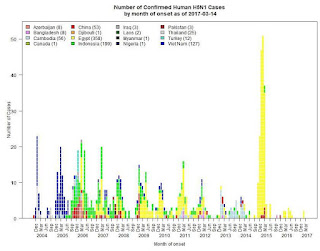#12,351
The World Health Organization has released an updated Influenza at the human-animal interface report - one that reflects H7N9 cases officially notified to WHO by the Chinese government through March 16th of this year, along with two H5N1 cases reported by Egypt in February.
Since this report is dated March 16th, and China doesn't always notify WHO immediately of cases, today's report is running about 40 behind Hong Kong's most recent tally.
First the summary, then some excerpts from the report:
As the chart at the top of this blow shows, after a record-breaking winter/spring of human cases in 2014-15, case reports dropped dramatically. We still hear of `possible' cases in the Egyptian media (see Egypt: Peering Down The Rabbit Hole), but so far in 2017 Egypt has only confirmed two cases:
Summary and assessment, 14 February to 16 March 2017
- New infections1: Since the previous update, new human infections with influenza A(H5N1) and A(H7N9) viruses were reported.
- Risk assessment: The overall public health risk from currently known influenza viruses at the human-animal interface has not changed, and the likelihood of sustained human-to-human transmission of these viruses remains low. Further human infections with viruses of animal origin are expected.
- IHR compliance: All human infections caused by a new influenza subtype are required to be reported under the International Health Regulations (IHR, 2005).2 This includes any animal and non-circulating seasonal influenza viruses. Information from these notifications is critical to inform risk assessments for influenza at the human-animal interface.
The report continues:
Avian influenza A(H5) viruses
Current situation:
Since the last update, two new laboratory-confirmed human cases of influenza A(H5N1) virus infection were reported to WHO. A 4-year-old male resident of Menia Governorate, Egypt, had onset of illness on 2 February 2017, was hospitalized on 10 February and treated with antivirals for pneumonia. A sample collected on admission tested positive for influenza A(H5N1). The patient recovered and was discharged on 20 February. Prior to his illness, the case had contact with domestic birds in his household.
In addition, a 48-year-old man from Fayoum Governorate had onset of illness on 10 February 2017, was hospitalized on 15 February and treated with antivirals for pneumonia. A sample collected on admission tested positive for influenza A(H5N1). The patient developed severe disease and passed away on 24 February. Prior to his illness, the case had contact with sick and dead backyard poultry.
Investigation and follow up of contacts of the two cases took place for 14 days with no further cases reported. Avian influenza A(H5N1) viruses are enzootic in poultry in Egypt.
Since 2003, a total of 858 laboratory-confirmed cases of human infection with avian influenza A(H5N1) virus, including 453 deaths, have been reported to WHO from 16 countries (see Figure 1).
Influenza A(H5) subtype viruses have the potential to cause disease in humans and thus far, no human cases, other than those with influenza A(H5N1) and A(H5N6) viruses, have been reported to WHO. According to reports received by the World Organisation for Animal Health (OIE), various influenza A(H5) subtypes continue to be detected in birds in West Africa, Europe and Asia. There have also been numerous detections of influenza A(H5N8) viruses in wild birds and domestic poultry in several countries in Africa, Asia and Europe since June 2016, and influenza A(H5N5) in wild birds in Europe. For more information on the background and public health risk of these viruses, please see the WHO assessment of risk associated with influenza A(H5N8) virus here.
(SNIP)
Avian influenza A(H7N9) viruses
Current situation:
During this reporting period, 84 laboratory-confirmed human cases of influenza A(H7N9) virus infection were reported to WHO from China. Case details are presented in the table in the Annex of this document. For additional details on these cases, public health interventions, and the recently detected influenza A(H7N9) viruses with genetic changes consistent with highly pathogenic avian influenza, see the Disease Outbreak News, and for analysis of recent scientific information on the A(H7N9) influenza virus, please see a recent WHO publication here.
As of 16 March 2017, a total of 1307 laboratory-confirmed cases of human infection with avian influenza A(H7N9) viruses, including at least 489 deaths3, have been reported to WHO (Figure 2).
According to reports received by the Food and Agriculture Organization (FAO) on surveillance activities for avian influenza A(H7N9) viruses in China4, positives among virological samples continue to be detected mainly from live bird markets, vendors and some commercial or breeding farms.
(Continue . . . )
While the risk assessments for these two viruses remains unchanged - and the virus has not demonstrated the ability to transmit efficiently from human to human - it is fair to say that recent developments with H7N9 have raised concerns world wide.
- This year's surge in human cases not only ends a two year decline in the number of human infections, it appears likely to double the size of biggest previous epidemic (winter 2013-14).
- H7N9 has recently split into two major lineages - Pearl River Delta and Yangtze River Delta - (see MMWR:Increase in Human Infections with Avian Influenza A(H7N9) In China's 5th Wave) This new lineage will require a new vaccine - meanwhile the virus continues to evolve at an impressive rate.
- Previously only an LPAI virus, a new virulent (in birds) HPAI version of H7N9 emerged in Guangdong province this winter, and has demonstrated the ability to infect humans.
- And just last week we learned that this HPAI H7N9 virus is mobile, and `fit' enough to have turned up in a different province, several hundred miles away from it first appeared (see China MOA: High Mortality In Poultry Infected With H7N9 In Hunan Province).
Download the PDF File to read the entire report.

